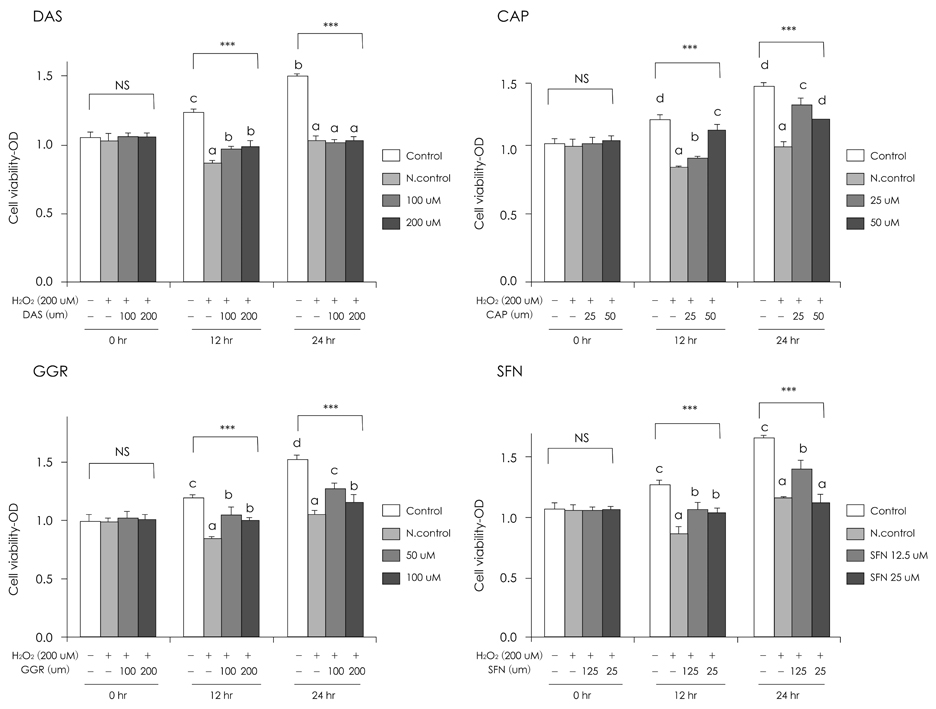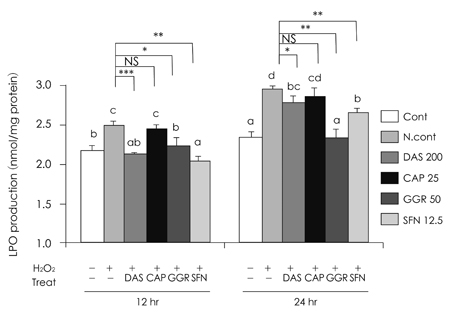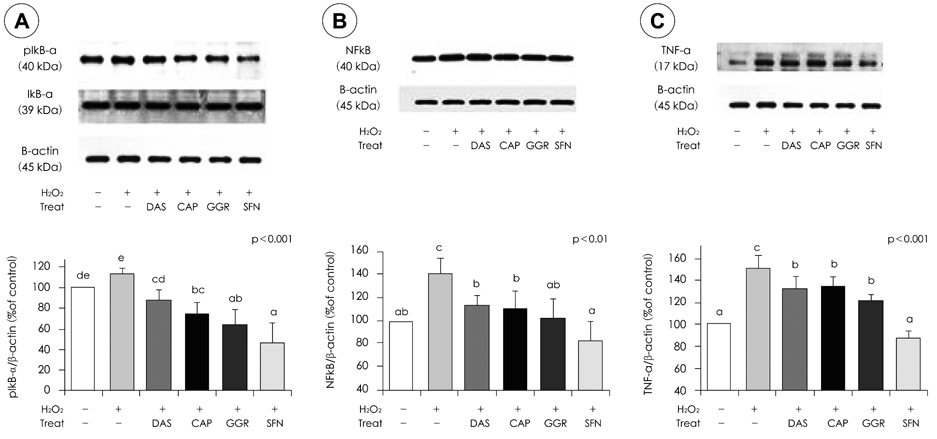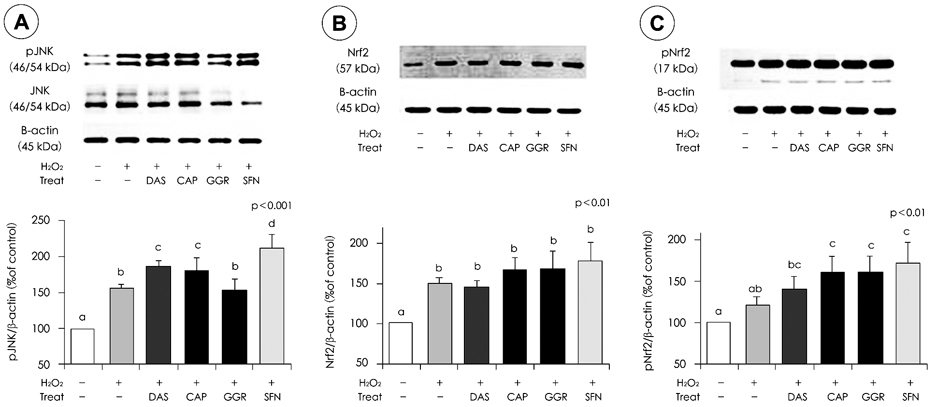Korean J Nutr.
2011 Dec;44(6):488-497. 10.4163/kjn.2011.44.6.488.
Comparison of the Antioxidant Effects of Diallyl Sulfide, Capsaicin, Gingerol and Sulforaphane in H2O2-Stressed HepG2 Cells
- Affiliations
-
- 1Department of Food and Nutrition and Research Institute of Obesity Sciences, Sungshin Women's University, Seoul 136-742, Korea. mlee@sungshin.ac.kr
- KMID: 2268609
- DOI: http://doi.org/10.4163/kjn.2011.44.6.488
Abstract
- Oxygen is necessary to sustain life, yet cellular oxygen metabolism creates destructive elements called free radicals. Free radicals are chemically unbalanced and carrying free electrons that can damage molecules, potentially damaging the cell itself. For this reason, many antioxidant products, including supplements and functional foods, are being developed. In particular, natural products are rich sources of pharmacologically active compounds. The purpose of this study was to investigate the antioxidant effects of target biomaterials in Korean traditional spices such as diallyl sulfide (DAS), capsaicin (CAP), and gingerol (GGR), and to investigate the response of the antioxidant defense system to oxidative stress by hydrogen peroxide (H2O2) compared to sulforaphane (SFN) in HepG2 cells. After the analysis of the cell viability using Cell Counting kit-8 (CCK-8) assay, we determined that the optimum levels were 200 microM DAS, 25 microM CAP, 50 microM GGR, and 12.5 microM SFN. Antioxidant enzymes were measured and protein expression was detected by Western blotting. All treatments showed a significant decrease in antioxidant enzyme activity such as superoxide dismutase, catalse, and glutathione peroxidase in HepG2 cells. Additionally, DAS, CAP, GGR and SFN increased the antioxidant system-related transcription factor Nrf2 which was found to be regulated by the activation of MAPK-JNK in this study. In conclusion, these results indicate the protective effects of DAS CAP, GGR, and SFN against H2O2-induced oxidative stress.
Keyword
MeSH Terms
-
4-Acetamido-4'-isothiocyanatostilbene-2,2'-disulfonic Acid
Allyl Compounds
Antioxidants
Biocompatible Materials
Biological Agents
Blotting, Western
Capsaicin
Catechols
Cell Count
Cell Survival
Electrons
Fatty Alcohols
Free Radicals
Functional Food
Glutathione Peroxidase
Hep G2 Cells
Hydrogen Peroxide
Lifting
Oxidative Stress
Oxygen
Spices
Sulfides
Superoxide Dismutase
Thiocyanates
Transcription Factors
4-Acetamido-4'-isothiocyanatostilbene-2,2'-disulfonic Acid
Allyl Compounds
Antioxidants
Biocompatible Materials
Biological Agents
Capsaicin
Catechols
Fatty Alcohols
Free Radicals
Glutathione Peroxidase
Hydrogen Peroxide
Oxygen
Sulfides
Superoxide Dismutase
Thiocyanates
Transcription Factors
Figure
Reference
-
1. Statistics Korea. 2007. http://kostat.go.kr.2. Homan R, Grossman JE, Pownnall HJ. Differential effects of eicosapentaenoic acid and oleic acid on lipid synthesis and secretion by HepG2 cells. J Lipid Res. 1991. 32:231–241.
Article3. Deby C, Gautier R. New perspectives on the biochemistry of superoxide anion and the efficiency of superoxide dismutase. Biochem Pharmacol. 1990. 39(3):399–405.
Article4. Chance B, Sies H, Boveris A. Hydroperoxide metabolism in mammalian organs. Physiol Rev. 1979. 59(3):527–605.
Article5. Takahashi M, Shibata M, Niki E. Estimation of lipid peroxidation of live cells using fluorescent probe. Free Radic Biol Med. 2001. 31(2):164–174.6. Fuster V, Alexander RW, O'Rourke RA. Hurst's The Heart. 2001. 10th ed. New York: McGraw-Hill;161–175.7. Melov S. Mitochondrial oxidative stress. Physiologic consequences and potential for a role in aging. Ann N Y Acad Sci. 2000. 908:219–225.
Article8. Minczuk M, Papworth MA, Kolasinska P, Murphy MP, Klug A. Sequence-specific modification of mitochondrial DNA using a chimeric zinc finger methylase. Proc Natl Acad Sci USA. 2006. 103(52):19689–19694.
Article9. De Duve C, Baudhuin P. Peroxisomes (microbodies and related particles). Physiol Rev. 1966. 46(2):323–357.
Article10. Awasthi YC, Beutler E, Srivastava SK. Purification and properties of human erythrocyte glutathione peroxidase. J Biol Chem. 1975. 250(13):5144–5149.
Article11. Kuramoto T. Development and application of food materials from plant extract such as SOD. Fd Process. 1992. 27:22–23.12. Horton AA, Fairhurst S. Lipid peroxidation and mechanisms of toxicity. Crit Rev Toxicol. 1987. 18(1):27–79.
Article13. Yoshizumi M, Abe J, Haendeler J, Huang Q, Berk BC. Src and Cas mediate JNK activation but not ERK1/2 and p38 kinases by reactive oxygen species. J Biol Chem. 2000. 275(16):11706–11712.
Article14. Lee M, Bae MA. Docosahexaenoic acid induces apoptosis in CYP2E1-containing HepG2 cells by activating the c-Jun N-terminal protein kinase related mitochondrial damage. J Nutr Biochem. 2007. 18(5):348–354.
Article15. Chen C, Yu R, Owuor ED, Kong AN. Activation of antioxidant-response element (ARE), mitogen-activated protein kinases (MAPKs) and caspases by major green tea polyphenol components during cell survival and death. Arch Pharm Res. 2000. 23(6):605–612.
Article16. Morimitsu Y, Nakagawa Y, Hayashi K, Fujii H, Kumagai T, Nakamura Y, Osawa T, Horio F, Itoh K, Iida K, Yamamoto M, Uchida K. A Sulforaphane analogue that potently activates the Nrf2-dependent detoxification Pathway. J Biol Chem. 2002. 277(5):3456–3463.
Article17. Spencer SR, Xue LA, Klenz EM, Talalay P. The potency of inducers of NAD(P)H: (quinone-acceptor) oxidoreductase parallels their efficiency as substrates for glutathione transferases. Structural and electronic correlations. Biochem J. 1991. 273(Pt 3):711–717.
Article18. Kim EH, Sohn S, Kwon HJ, Kim SU, Kim MJ, Lee SJ, Choi KS. Sodium Selenite Induces Superoxide-Mediated Mitochondrial Damage and Subsequent Autophagic Cell Death in Malignant Glioma Cells. Cancer Res. 2007. 67(13):6314–6324.
Article19. Liu Y, Borchert GL, Donald SP, Surazynski A, Hu CA, Weydert CJ, Oberley LW, Phang JM. MnSOD inhibits proline oxidase-induced apoptosis in colorectal cancer cells. Carcinogenesis. 2005. 26(8):1335–1342.
Article20. Radu M, Munteanu MC, Petrache S, Serban AI, Dinu D, Hermenean A, Sima C, Dinischiotu A. Depletion of intracellular glutathione and increased lipid peroxidation mediate cytotoxicity of hematite nanoparticles in MRC-5 cells. Acta Biochim Pol. 2010. 57(3):355–360.
Article21. Sahara N, Takeshita A, Kobayashi M, Shigeno K, Nakamura S, Shinjo K, Naito K, Maekawa M, Horii T, Ohnishi K, Kitamura K, Naoe T, Hayash H, Ohno R. Phenylarsine oxide (PAO) more intensely induces apoptosis in acute promyelocytic leukemia and As2O3-resistant APL cell lines than As2O3 by activating the mitochondrial pathway. Leuk Lymphoma. 2004. 45(5):987–995.
Article22. Patlolla AK, Barnes C, Hackett D, Tchounwou PB. Potassium dichromate induced cytotoxicity, genotoxicity and oxidative stress in human liver carcinoma (HepG2) cells. Int J Environ Res Public Health. 2009. 6(2):643–653.
Article23. Duthie GG, Duthie SJ, Kyle JA. Plant polyphenols in cancer and heart disease: implications as nutritional antioxidants. Nutr Res Rev. 2000. 13(1):79–106.
Article24. Baek YM, Hwang HJ, Kim SW, Hwang HS, Lee SH, Kim JA, Yun JW. A comparative proteomic analysis for capsaicin-induced apoptosis between human hepatocarcinoma (HepG2) and human neuroblastoma (SK-N-SH) cells. Proteomics. 2008. 8(22):4748–4767.
Article25. Tarozzi A, Morroni F, Merlicco A, Hrelia S, Angeloni C, Cantelli-Forti G, Hrelia P. Sulforaphane as an inducer of glutathione prevents oxidative stress-induced cell death in a dopaminergic-like neuroblastoma cell line. J Neurochem. 2009. 111(5):1161–1171.
Article26. Kikuzaki H, Kawasaki Y, Nakatani N. Structure of antioxidative compounds in ginger. Food Phytochemicals for Cancer Prevention II. ACS Symposium Series. 1994. (547):Washington: ACS publications;237–243.
Article27. Prasad S, Kalra N, Shukla Y. Modulatory effects of diallyl sulfide against testosteroneinduced oxidative stress in Swiss albino mice. Asian J Androl. 2006. 8(6):719–723.
Article28. Pirmohamed M, Williams D, Tingle MD, Barry M, Khoo S, O'Mahony C, Wilkins EG, Breckenridge AM, Park BK. Intracellular glutathione in the peripheral blood cells of HIV-infected patients: failure to show a deficiency. AIDS. 1996. 10(5):501–507.
Article29. Samiec PS, Drews-Botsch C, Flagg EW, Kurtz JC, Sternberg P Jr, Reed RL, Jones DP. Glutathione in human plasma: decline in association with aging, age-related macular degeneration and diabetes. Free Radic Biol Med. 1998. 24(5):699–704.
Article30. Degl'Innocenti D, Rosati F, Iantomasi T, Vincenzini MT, Ramponi G. GSH system in relation to redox state in dystrophic skin fibroblasts. Biochimie. 1999. 81(11):1025–1029.31. Chung FL, Wang M, Rivenson A, Iatropoulos MJ, Reinhardt JC, Pittman B, Ho CT, Amin SG. Inhibition of lung carcinogensis by black tea in Fischer rats treated with a tobacco-specific carcinogen: caffeine as an important constituent. Cancer Res. 1998. 58(18):4096–4101.32. Hail N Jr, Lotan R. Examining the role of mitochondrial respiration in vanilloid-induced apoptosis. J Natl Cancer Inst. 2002. 94(17):1281–1292.
Article33. Itoh K, Chiba T, Takahashi S, Ishii T, Igarashi K, Katoh Y, Oyake T, Hayashi N, Satoh K, Hatayama I, Yamamoto M, Nabeshima Y. An Nrf2/small Maf heterodimer mediates the induction of phase II detoxifying enzyme genes through antioxidant response elements. Biochem Biophys Res Commun. 1997. 236(2):313–322.
Article34. Granado-Serrano AB, Martín MA, Haegeman G, Goya L, Bravo L, Ramos S. Epicatechin induces NF-kappaB, activator protein-1 (AP-1) and nuclear transcription factor erythroid 2p45- related factor-2 (Nrf2) via phosphatidylinositol-3-kinase/protein kinase B (PI3K/AKT) and extracellular regulated kinase (ERK) signalling in HepG2 cells. Br J Nutr. 2010. 103(2):168–179.
Article35. Kwak MK, Wakabayashi N, Itoh K, Motohashi H, Yamamoto M, Kensler TW. Modulation of gene expression by cancer chemopreventive dithiolethiones through the Keap1-Nrf2 pathway. Identification of novel gene clusters for cell survival. J Biol Chem. 2003. 278(10):8135–8145.
Article36. Ramos-Gomez M, Kwak MK, Dolan PM, Itoh K, Yamamoto M, Talalay P, Kensler TW. Sensitivity to carcinogenesis is increased and chemoprotective efficacy of enzyme inducers is lost in nrf2 transcription factor-deficient mice. Proc Natl Acad Sci USA. 2001. 98(6):3410–3415.
Article37. Chan K, Han XD, Kan YW. An important function of Nrf2 in combating oxidative stress: detoxification of acetaminophen. Proc Natl Acad Sci USA. 2001. 98(8):4611–4616.
Article38. McMahon M, Itoh K, Yamamoto M, Chanas SA, Henderson CJ, McLellan LI, Wolf CR, Cavin C, Hayes JD. The Cap'n'Collar basic leucine zipper transcription factor Nrf2 (NF-E2 p45-related factor2) controls both constitutive and inducible expression of intestinal detoxification and glutathione biosynthetic enzymes. Cancer Res. 2001. 61(8):3299–3307.39. Ramos-Gomez M, Dolan PM, Itoh K, Yamamoto M, Kensler TW. Interactive effects of nrf2 genotype and oltipraz on benzo[a] pyrene-DNA adducts and tumor yield in mice. Carcinogenesis. 2003. 24:461–467.
Article40. Chan JY, Kwong M. Impaired expression of glutathione synthetic enzyme genes in mice with targeted deletion of the Nrf2 basic-leucine zipper protein. Biochim Biophys Acta. 2000. 1517(1):19–26.
Article41. Halliwell B, Aruoma OI. DNA damage by oxygen-derived species: its mechanism and measurement in mammalian systems. FEBS Lett. 1991. 281(1-2):9–19.
Article42. Meyer M, Schreck R, Baeuerle PA. H2O2 and antioxidants have opposite effects on activation of NF-kB and AP-1 in intact cells: AP-1 as secondary antioxidant-responsive factor. EMBO J. 1993. 12(5):2005–2015.
Article43. Menghini R. Genotoxicity of active oxygen species in mammalian cells. Mutat Res. 1988. 195(3):215–230.
Article44. Thejass P, Kuttan G. Antiangiogenic activity of Diallyl Sulfide (DAS). Int Immunopharmacol. 2007. 7(3):295–305.
Article45. Blackwell TS, Christman JW. The role of nuclear factor-kappa B in cytokine gene regulation. Am J Respir Cell Mol Biol. 1997. 17(1):3–9.
Article46. Siebenlist U, Franzoso G, Brown K. Structure, regulation and function of NF-kappa B. Annu Rev Cell Biol. 1994. 10:405–455.47. Lee TY, Lee KC, Chen SY, Chang HH. 6-Gingerol inhibits ROS and iNOS through the suppression of PKC-a and NF-jB pathways in lipopolysaccharide-stimulated mouse macrophages. Biochem Biophys Res Commun. 2009. 382(1):134–139.
Article48. Song MY, Kim EK, Moon WS, Park JW, Kim HJ, So HS, Park R, Kwon KB, Park BH. Sulforaphane protects against cytokine- and streptozotocin-induced beta-cell damage by suppressing the NF-kappaB pathway. Toxicol Appl Pharmacol. 2009. 235(1):57–67.
Article49. Jin W, Wang H, Ji Y, Hu Q, Yan W, Chen G, Yin H. Increased ntestinal inflammatory response and gut barrier dysfunction in rf2-deficient mice after traumatic brain injury. Cytokine. 2008. 44(1):135–140.
Article
- Full Text Links
- Actions
-
Cited
- CITED
-
- Close
- Share
- Similar articles
-
- Antioxidant activity of ethanol extract of Lycium barbarum's leaf with removal of chlorophyll
- Apoptotic Effects of 6-Gingerol in Human Breast Cancer Cells
- Anti-oxidant and Hepatoprotective Effect of White Ginsengs in H2O2-Treated HepG2 Cells
- Diallyl Disulfide Inhibits Cytochrome c-Mediated Apoptosis in H2O2 Induced Death of Neuronal-differentiated PC12 Cells
- Effect of Hydrogen Sulfide on the Oxidative Stress and Senescence inTrabecular Meshwork Cells







